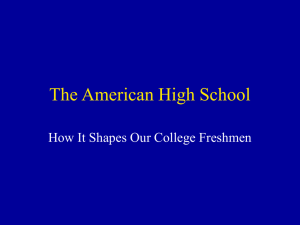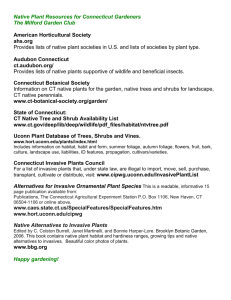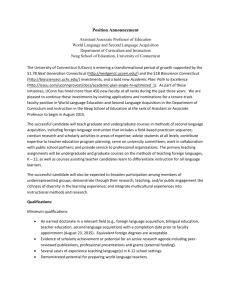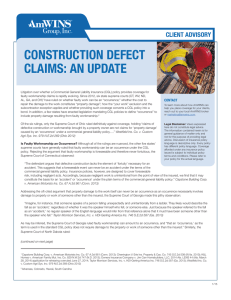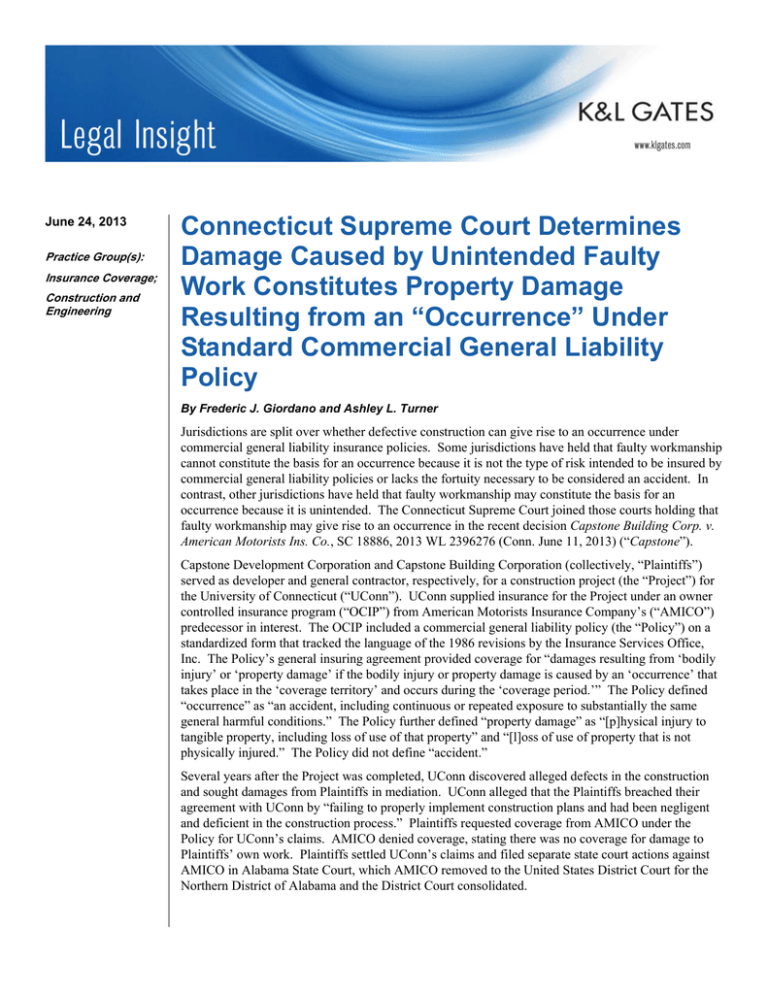
June 24, 2013
Practice Group(s):
Insurance Coverage;
Construction and
Engineering
Connecticut Supreme Court Determines
Damage Caused by Unintended Faulty
Work Constitutes Property Damage
Resulting from an “Occurrence” Under
Standard Commercial General Liability
Policy
By Frederic J. Giordano and Ashley L. Turner
Jurisdictions are split over whether defective construction can give rise to an occurrence under
commercial general liability insurance policies. Some jurisdictions have held that faulty workmanship
cannot constitute the basis for an occurrence because it is not the type of risk intended to be insured by
commercial general liability policies or lacks the fortuity necessary to be considered an accident. In
contrast, other jurisdictions have held that faulty workmanship may constitute the basis for an
occurrence because it is unintended. The Connecticut Supreme Court joined those courts holding that
faulty workmanship may give rise to an occurrence in the recent decision Capstone Building Corp. v.
American Motorists Ins. Co., SC 18886, 2013 WL 2396276 (Conn. June 11, 2013) (“Capstone”).
Capstone Development Corporation and Capstone Building Corporation (collectively, “Plaintiffs”)
served as developer and general contractor, respectively, for a construction project (the “Project”) for
the University of Connecticut (“UConn”). UConn supplied insurance for the Project under an owner
controlled insurance program (“OCIP”) from American Motorists Insurance Company’s (“AMICO”)
predecessor in interest. The OCIP included a commercial general liability policy (the “Policy”) on a
standardized form that tracked the language of the 1986 revisions by the Insurance Services Office,
Inc. The Policy’s general insuring agreement provided coverage for “damages resulting from ‘bodily
injury’ or ‘property damage’ if the bodily injury or property damage is caused by an ‘occurrence’ that
takes place in the ‘coverage territory’ and occurs during the ‘coverage period.’” The Policy defined
“occurrence” as “an accident, including continuous or repeated exposure to substantially the same
general harmful conditions.” The Policy further defined “property damage” as “[p]hysical injury to
tangible property, including loss of use of that property” and “[l]oss of use of property that is not
physically injured.” The Policy did not define “accident.”
Several years after the Project was completed, UConn discovered alleged defects in the construction
and sought damages from Plaintiffs in mediation. UConn alleged that the Plaintiffs breached their
agreement with UConn by “failing to properly implement construction plans and had been negligent
and deficient in the construction process.” Plaintiffs requested coverage from AMICO under the
Policy for UConn’s claims. AMICO denied coverage, stating there was no coverage for damage to
Plaintiffs’ own work. Plaintiffs settled UConn’s claims and filed separate state court actions against
AMICO in Alabama State Court, which AMICO removed to the United States District Court for the
Northern District of Alabama and the District Court consolidated.
Connecticut Supreme Court Determines Damage Caused
by Unintended Faulty Work Constitutes Property Damage
Resulting from an “Occurrence” Under Standard
Commercial General Liability Policy
Because the issue had not been decided under Connecticut law, the District Court asked the
Connecticut Supreme Court on certification to determine, among other things, whether damage to a
previously completed construction project, caused by defective construction or faulty workmanship,
can constitute property damage resulting from an occurrence. AMICO argued that “defective work
lacks the element of ‘fortuity’ necessary for an accident.” The Court disagreed. The Court looked to
its holdings in prior cases to determine that “an accident is an event that is unintended from the
perspective of the insured.” The Court went on to note that “the motive of the acting party is
determinative of whether an act was intentional or accidental.” The Court held that negligent work is
unintentional from the point of view of the insured and, therefore, should be covered under the CGL
Policy.
The Court’s analysis did not end after it determined that faulty workmanship can constitute the basis
for an occurrence, as it noted that property damage must result from such an occurrence in order to
trigger coverage under the Policy. The Court then examined the Policy’s definition of “property
damage” and concluded that physical injury to, or loss of use of, the insured’s property is within the
Policy’s initial insuring grant. Significantly, the Court held that damage to other portions of an
insured’s work caused by its defective work constitutes property damage (“water and mold damage to
portions of the insured’s project, beyond the defective work itself, would qualify as ‘physical injury to
tangible property’”). Id. at *7. Faulty workmanship standing alone, however, does not constitute
property damage, and coverage does extend to the cost to repair defective work itself.
The Court completed its analysis by examining whether various policy exclusions might apply to
eliminate coverage even though the claims triggered the insuring agreement. In particular, the Court
examined the “your work” exclusion, which bars coverage for property damage to an insured’s own
work, but does not apply if the insured’s own work was damaged by a subcontractor’s work. The
Court held that the entire project was Capstone’s work and, therefore, coverage was initially barred by
the exclusion, but that the “subcontractor exception” would restore coverage for any property damage
caused by subcontractors.
Capstone eliminates uncertainty as to whether and when coverage exists under Connecticut law for
property damage caused by faulty construction under standard-type CGL policies. Although
application in any particular case may be fact-sensitive, the Connecticut Supreme Court established
firm benchmarks, and policyholders facing construction-related claims under policies governed by
Connecticut law should understand these rules to assess how to maximize their insurance recovery.
Authors:
Frederic J. Giordano
frederic.giordano@klgates.com
+1.973.848.4035
Ashley L. Turner
ashley.turner@klgates.com
+1.973.848.4018
2
Connecticut Supreme Court Determines Damage Caused
by Unintended Faulty Work Constitutes Property Damage
Resulting from an “Occurrence” Under Standard
Commercial General Liability Policy
Anchorage Austin Beijing Berlin Boston Brisbane Brussels Charleston Charlotte Chicago Dallas Doha Dubai Fort Worth Frankfurt
Harrisburg Hong Kong Houston London Los Angeles Melbourne Miami Milan Moscow Newark New York Orange County Palo Alto Paris
Perth Pittsburgh Portland Raleigh Research Triangle Park San Diego San Francisco São Paulo Seattle Seoul Shanghai Singapore Spokane
Sydney Taipei Tokyo Warsaw Washington, D.C. Wilmington
K&L Gates practices out of 48 fully integrated offices located in the United States, Asia, Australia, Europe, the
Middle East and South America and represents leading global corporations, growth and middle-market companies,
capital markets participants and entrepreneurs in every major industry group as well as public sector entities,
educational institutions, philanthropic organizations and individuals. For more information about K&L Gates or its
locations, practices and registrations, visit www.klgates.com.
This publication is for informational purposes and does not contain or convey legal advice. The information herein should not be used or relied upon in
regard to any particular facts or circumstances without first consulting a lawyer.
©2013 K&L Gates LLP. All Rights Reserved.
3

